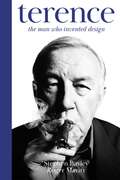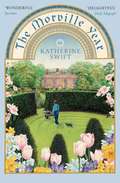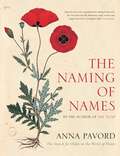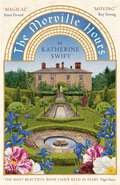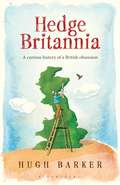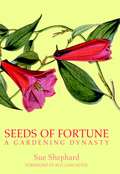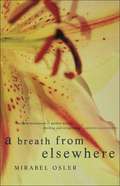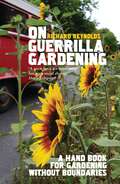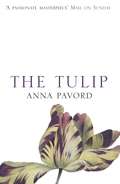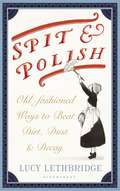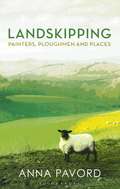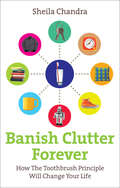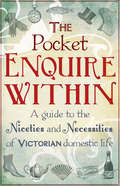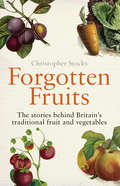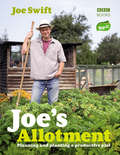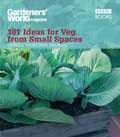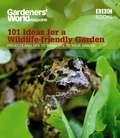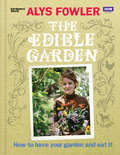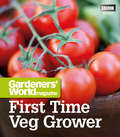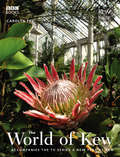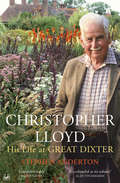- Table View
- List View
A Little Book of Latin for Gardeners
by Peter ParkerHow did the delphinium get its name? Which parts of the body lend their names to auriculas and orchids? Who are the gentian, lobelia and heuchera named after? Why are nasturtiums and antirrhinums connected? What does an everlasting pea have to do with Indian miniature paintings?These are some of the questions answered in Peter Parker's adventurous exploration of the mysteries of Botanical Latin.Evolved over many centuries and often thought to belong to the rarefied world of scholars and scientists, this invented language is in fact a very useful tool for everyday gardening. It allows us to find our way around nurseries; it sorts out confusions when two plants have the same English name; and it gives us all kinds of information about how big or small a plant will grow, what shape or colour it will develop, and what habitat it prefers.In his lively survey, Parker agues that Botanical Latin is not merely useful, but fun. The naming of plants draws upon geography, social and medical history, folklore, mythology, language, literature, the human body, the animal kingdom and all manner of ancient beliefs and superstitions.The book, beautifully illustrated with old woodcuts, explains how and why plants have been named, includes handy lists of identifying adjectives, and takes the reader down some of the stranger byways of human endeavour and eccentricity.
Terence: The Man Who Invented Design
by Roger Mavity Stephen BayleyTerence Conran, a visionary and a myopic. A design entrepreneur and imaginative restaurateur, he was a democratising idealist who was also a selfish hedonist. His influence is everywhere in modern Britain from where we live to what we eat. Terence: The Man Who Invented Design is the most definitive, intimate and revelatory biography of this design legend, by two of his closest collaborators, Roger Mavity and Stephen Bayley. Frank, amusing, indiscreet, sharp, rude, respectful and knowing, it tells Terence's story as it evolved, from before Habitat's humble chicken brick to Bibendum's sophisticated poulet de Bresse, via personal successes and corporate calamities, culminating in that peculiar temple to the religion he invented: The Design Museum. It celebrates Terence's genius and immeasurable impact on British life - and ensures his rightful status as national treasure. Terence: The Man Who Invented Design is the most candid, up-close insight into the man and myth.
The Morville Year
by Katherine SwiftOne of the most admired gardening writers of her generation, Katherine Swift returns to describe a year in the life of her garden she created over twenty years in the grounds of the Dower House at Morville, Shropshire, meditating on everything from the terrain and its history, to the plants and trees, and the odd habits of the animals and humans who inhabit the garden.Following the turning wheel of the Morville seasons, from the green shoots of spring, through summer and autumn, to the stark beauty of winter, and back to spring again, The Morville Year is a journal full of surprises and enchantments that will appeal not only to gardeners, but to all who enjoy the natural world.
The Curious Gardener
by Anna PavordIn The Curious Gardener, Anna Pavord brings together in 12 chapters - one from each month of the year - 72 pieces on all aspects of gardening. From what to do in each month and how to get the best from flowers, plants, herbs, fruit and vegetables, through reflections on the weather, soil, the English landscape and favourite old gardening clothes, to office greenery, spring in New York, waterfalls, Derek Jarman and garden design, Anna Pavord always has something interesting to say and says it with great style and candour.The perfect book to guide you through the gardening year and, on days when the weather keeps the most courageous gardener indoors, the perfect book to curl up with beside the fire.
The Naming of Names: The Search for Order in the World of Plants
by Anna PavordFor centuries, some of the most brilliant minds in Europe searched for the rules of nature's game. In a world full of plagues and poisons, many medicines were made from plant extracts and there was a practical need to differentiate between one plant and another. Alongside this was an overwhelming desire to make sense of the natural world. Scholars, aided by the artists who painted the first pictures of plants, set out looking, writing and classifying, but 2,000 years were to pass before any rules became clear. Anna Pavord takes us on an exhilarating and fascinating journey through botanical history, travelling from Athens in the third century BC, through Constantinople and Venice, Padua and Pisa to the present day.
The Morville Hours: The Story of a Garden
by Katherine SwiftIn 1988 Katherine Swift arrived at the Dower House at Morville to create a garden of her own. This beautifully written, utterly absorbing book is the history of the many people who have lived in the same Shropshire house, tending the same soil, passing down stories over the generations. Spanning thousands of years, The Morville Hours takes the form of a medieval Book of Hours. It is a meditative journey through the seasons, but also a journey of self-exploration. It is a book about finding one's place in the world and putting down roots.
Hedge Britannia: A Curious History of a British Obsession
by Hugh BarkerThis is the story of how Britishhedgerows contribute to our national identity and our wildlife. Overthe centuries we have proved ourselves to be a nation of hedge growers,marking boundaries or trimming them into fantastical creations. Fromformal garden features to emphatically rustic barriers, Hugh exploresour hedges in all their diversity.Hedge Britannia offers a wittyinsight into the history of hedges and the way they relate to ourculture as well as our landscape. Hugh travels the breadth of Britainmeeting fellow enthusiasts who range from horticultural experts to theBrixton man who lovingly cultivated a whale-shaped hedge and ran intotrouble with the local council. As well as two full-colour platesections, there are case studies about hedges of particular note, likethe towering Meikleour beech hedge, the castellated hedge and spectacular topiary at LevensHall and the bamboozling hedge maze at Chatsworth (where Hugh gotpredictably and happily lost).Both pithy and informative, this is The Cloudspotter's Guide meets Flora Britannica.
A Gentle Plea for Chaos: Reflections From An English Garden
by Mirabel OslerIn this book the author describes the way her garden evolved and how, without meaning to do so, she let it take over her life. She suggests moving away from planning, regimentation and gardening with the mentality of a stamp-collector. Frequently funny and always stimulating, she writes of the alchemy of gardens, of the 19th-century plant-collectors and plant illustrators and of the gardening philosophers, all fertilizing great thoughts along with their hollyhocks. She won the 1988 Sinclair Consumer Press Garden Writer of the Year Award.
Seeds of Fortune: A Gardening Dynasty
by Sue Shephard Roy LancasterFor over a century, and across five generations, the Veitch family pioneered the introduction of hundreds of new plants into gardens, conservatories and houses and were amongst the foremost European cultivators and hybridisers of their day. The story begins in 1768 when a Scotsman called John Veitch came to England to find his fortune, starting out as a gardener for the aristocracy. Realising that horticultural mania had begun to spread throughout the social classes, John's son, James, opened a nursery in Exeter and began to send some of the first commercial plant collectors into the Americas, Australia, India, Japan, China and the South Seas. By the beginning of the twentieth century, the Veitch's had become key figures within the gardening establishment, involved with the Royal Horticultural Society from its beginnings and the great Chelsea Flower Show. Combining an historian's eye for detail with a flair for storytelling, Shephard charts the fortunes of one family and through them tells the fascinating story of the modern English garden.
A Breath from Elsewhere: Musings on Gardens
by Mirabel OslerMirabel Osler attempts in this work to take the reader beyond her own garden, offering encouragement to all gardeners, especially novices, to ignore books and try whatever appeals to them.
On Guerrilla Gardening: A Handbook for Gardening without Boundaries
by Richard ReynoldsOn Guerrilla Gardening is an activist's call to arms to all citizens - green-fingered, green-thinking or curious - to join the revolution of guerrilla gardening: transforming public space into oases of colour and life. The enemy: neglect, apathy and the disintegration of community spirit. The arsenal: daring, a packet of seeds and a passionate commitment to social change. When Richard Reynolds first embarked on guerrilla gardening, growing flowers by moonlight outside his tower block, he had no idea it was part of a growing global movement committed to cultivating the potential in the land regardless of all obstacles. Charting the battles fought across thirty different countries and the revolutionary history of this subculture, On Guerrilla Gardening is an inspirational take on gardening in the 21st century.
The Tulip: Twentieth Anniversary Edition
by Anna PavordTHE TULIP is not a gardening book. It is the story of a flower that has made men mad. Greed, desire, anguish and devotion have all played their part in the development of the tulip into the world-wide phenomenon it is today. No other flower has ever carried so much cultural baggage; it charts political upheavals, illuminates social behaviour, mirrors economic booms and busts, plots the ebb and flow of religious persecution. Pavord tells how the tulip arrived from Turkey and took the whole of Western Europe by storm. Sumptuously illustrated from a wide range of sources, this beautifully produced and irresistible volume will become a bible, a unique source book, a universal gift book and a joy to all who possess it.
Spit and Polish: Old-Fashioned Ways to Banish Dirt, Dust and Decay
by Lucy LethbridgeIn the late nineteenth century, general housework in the British home was so labour intensive that it required an army of servants to undertake it. Since then, the ways in which we look after our homes may have changed dramatically but the best and simplest of methods from that time still work for us today.From floor to ceiling, and leaving no awkward corner untouched, here are the tricks and techniques that generations once took for granted, distilled for modern use: how to get rid of water marks or heat rings on polished wood; the antibacterial qualities of simple vinegar; the damp cloth versus the dry duster; and using lemon juice to clear limescale. Combining fascinating 'below-stairs' social history with startling facts and useful tips, Lucy Lethbridge restores fast-disappearing skills to keep at bay dust, rust, mildew, stains and pests. Here, beautifully illustrated and entertainingly presented, are a bygone era's keys to a clean house.
Landskipping: Painters, Ploughmen and Places
by Anna PavordLandskipping is a ravishing celebration of landscape, its iridescent beauty and its potential to comfort, awe and mesmerise. In spirit as Romantic as rational, Anna Pavord explores the different ways in which we have, throughout the ages, responded to the land. In the eighteenth century, artists first started to paint English scenery, and the Lakes, as well as Snowdon, began to attract a new kind of visitor, the landscape tourist. Early travel guides sought to capture the beauty and inspiration of waterfall, lake and fell. Sublime! Picturesque! they said, as they laid down rules for correctly appreciating a view. While painters painted and writers wrote, an entirely different band of men, the agricultural improvers, also travelled the land, and published a series of remarkable commentaries on the state of agricultural England. They looked at the land in terms of its usefulness as well as its beauty, and, using their reports, Anna Pavord explores the many different ways that land was managed and farmed, showing that what is universal is a place's capacity to frame and define our experience.Moving from the rolling hills of Dorset to the peaks of the Scottish Highlands, this is an exquisite and compelling book, written with zest, passion and deep understanding.
Banish Clutter Forever: How the Toothbrush Principle Will Change Your Life
by Sheila ChandraWhy is it that even the most disorganised person never seems to lose their toothbrush? How can this simple fact solve all our clutter problems?The Toothbrush Principle is a simple yet inspired approach to de-cluttering your home. Whether you live in a mansion or a bedsit, this book will show you how to: organise according to the unconscious blueprint that naturally tidy people have, so that getting and staying organised is easy; know what to throw away with confidence; set up your wardrobe so you get much more use out of the clothes you have; work from home productively in a clear, designated space; tame your inbox!Step-by-step, room-by-room, you'll soon find that you hardly ever lose things, massive clear outs become a thing of the past and you never spend more than 10 minutes a day tidying up.So stop drowning in piles of clutter, learn how to be organised and start creating space to live out the life of your dreams!
How to Buy Your First Home (And How to Sell it Too): Your Property Expert
by Phil SpencerPhil Spencer, property expert and co-presenter of hit series Location, Location, Location, provides everything you need to know to help you buy (and sell) your first homeWant to own your own home, but not sure where to start? Need some friendly advice from a property professional?In How to Buy Your First Home, property expert Phil Spencer takes the worry out of the property market. Breaking everything down into simple and achievable steps, he makes this daunting process easy. Learn how to:- Find your perfect pad- Choose which mortgage is right for you- Negotiate with estate agents and sellers- Organise exchange and completion Including indispensable advice, money-saving tips and an essential trouble-shooting section, this guide covers everything a first-time buyer needs to know. And when it's time to move on again, this book will show you how to sell your home too.Phil Spencer is one the best-known faces on British television, co-presenting the hit Channel 4 series Location, Location, Location and Relocation, Relocation. Phil has written regularly columns in The Sunday Times and Country Life, and is contracted to Archant publishing to write columns that are syndicated in the group's numerous local glossy magazines which are distributed nationwide. Recent TV appearances include on The One Show, Children in Need and The Friday Night Project, and Phil also regularly appears on the radio to discuss property issues.
The Pocket Enquire Within: A guide to the niceties and necessities of Victorian domestic life
by George ArmstrongWhat is the correct way to carve a partridge?How should leeches be applied?How can egg whites be used to repair broken china?First published in 1856, Enquire Within rapidly became the indispensable guide to Victorian domestic life. Packed with words of wisdom and pithy advice, it covered everything from entertaining and etiquette to household management, and took in considered discussion of such arcane matters as how singing might prevent consumption, and which ointments will remove freckles, not to mention why chess should on no account ever be played at a ball.This new, charmingly illustrated pocket-sized edition contains a selection of hints and tips that not only provide a fascinating insight into the day-to-day life of Victorian Britain, but also, in places, reveal timeless wisdom that we would do well to heed today.
Forgotten Fruits: The stories behind Britain's traditional fruit and vegetables
by Christopher StocksIn Forgotten Fruits, Christopher Stocks tells the fascinating - often rather bizarre - stories behind Britain's rich heritage of fruit and vegetables. Take Newton Wonder apples, for instance, first discovered around 1870 allegedly growing in the thatch of a Derbyshire pub. Or the humble gooseberry which, among other things, helped Charles Darwin to arrive at his theory of evolution. Not to mention the ubiquitous tomato, introduced to Britain from South America in the sixteenth century but regarded as highly poisonous for hearly 200 years.This is a wonderful piece of social and natural history that will appeal to every gardener and food aficionado.
Joe's Allotment: Planning and planting a productive plot
by Joe SwiftWith hardly any previous veg-growing experience and even less time, when Gardener's World design guru Joe Swift decided to take on a 250 sq metre allotment in north London, some people thought he was mad. But with hard work and dedication, in less than a year Joe created his very own urban oasis and a source of delicious, fresh, organic produce for himself and his family.In this book Joe takes us through every stage of his education as an allotment gardener, from putting his name on the council waiting list to harvesting his first crops. He reveals everything he's learned about acquiring a plot, clearing the site, planning the beds, and planting, nurturing and protecting his fruit and vegetables. All the techniques he has mastered are described and illustrated, step by step.Joe also introduces us to his Veg Heroes like Monty Don and Geoff Hamilton - fellow plot-holders with years of experience and the crops to show for it - who inspired Joe to take up veg growing in the first place. And he shares with us his enjoyment of allotment gardening, the combination of hard work, fresh air and a sense of community that makes his plot such a special place to be.Whether you are an established allotment gardener or are thinking of putting your name down for a plot, Joe's Allotment will provide you with a wealth of advice and inspiration.
Gardeners' World: 101 Ideas For Veg From Small Spaces
by Jane MooreWhat can be more convenient than being able to nip into the garden to pick some salad for lunch, some herbs for the pot or some fresh veg or fruit for dinner? Nothing beats the flavour of home-grown produce, or, in these days of additives and preservatives, the reassurance of knowing what is in your food. Contrary to popular belief, you don't need an enormous garden, or a dedicated spot within it to grow your own, nor do you need to join the mammoth waiting lists for a local allotment; all you need is a window ledge, some steps, a patio, some wall space or even some gaps in your flower borders.In this handy book the team at Gardeners' World Magazine will give you loads of tips on how to get started if you've never grown fruit or vegetables before, suggest some fun and practical ways you can grow your favourite crops in a limited space or small garden, and tell you how to get the best from what you grow. Growing your own has never been more popular or more simple, and in this essential little guide, packed with inspirational ideas and advice from Gardeners' World Magazine, everyone can get in on the act. So what's stopping you now? Go on, grow your own grub!
Gardeners' World: 101 Ideas For A Wildlife-friendly Garden
by Mick LavelleIf you yearn to watch blackbirds feeding their young, and butterflies flitting amongst the flowers but you don't have the space for a meadow or want to give your whole garden over to nature, don't despair: with just a few clever tricks you can bring the countryside and its residents to your garden, even in the most urban of locations. Encouraging a little wildlife into your garden can bring a lot of benefits for the gardener. Having a wildlife-friendly garden isn't just about letting nature do its thing so that you can enjoy watching it from your window or the patio, it has a far more important contribution to make. Let nature do the hard work of gardening for you: ladybirds and blue tits will make short work of aphids, while birds, bats and hedgehogs will feast on larger insects. It's biological control at its best; leaving you more time to sit in your deck chair and listen to the dawn chorus of the birds, the croaking of frogs, and the nighttime grunting of visiting hedgehogs. If the natural look of a wildlife garden isn't your thing, you'll be pleased to know that even the most modern, minimalist garden can include features which will bring in wildlife without cramping your style. In this book, the team at Gardeners' World Magazine bring you tips and advice on simple ways in which you can create a haven for wildlife - whatever your garden style.
The Edible Garden: How to Have Your Garden and Eat It
by Alys FowlerIn this timely book, Gardeners' World's thrifty and resourceful Alys Fowler shows that there is a way to take the good life and re-fashion it to fit in with life in the city. Abandoning the limitations of traditional gardening methods, she has created a beautifully productive garden where tomatoes sit happily next to roses, carrots are woven between the lavenders and potatoes grow in pots on the patio. And all of this is produced in a way that mimics natural systems, producing delicious homegrown food for her table. And she shares her favourite recipes for the hearty dishes, pickles and jams she makes to use up her bountiful harvest, proving that no-one need go hungry on her grow-your-own regime. Good for the pocket, good for the environment and hugely rewarding for the soul, The Edible Garden urges urbanites everywhere to chuck out the old gardening rules and create their own haven that's as good to look at as it is to eat.
Gardeners' World: First Time Veg Grower
by Martyn CoxWhen it comes to fresh vegetables, nothing comes close to growing your own - but where to start? For those of us that crave the crisp taste of home-grown tomatoes, peppers, courgettes and more but lack the crucial experience and know-how, it can be difficult to make those first steps to transform a barren patch into a luscious kitchen garden - even for experienced gardeners, the move from decorative gardening to practical vegetable growing can prove tricky.Gardeners' World: First Time Veg Grower can help you make that journey, with simple and practical expert advice from the moment you first don your wellies right up until you're harvesting your own crops. With step-by-step guides and clear colour illustrations helping you to get the most out of your plot all year round, this compact guide is an essential addition to any gardener's shelf. From preparing your ground to sowing, nurturing and maintaining your plants, let the practiced hands at the UK's best-selling gardening magazine help you create the vegetable patch of your dreams.
The World of Kew
by Carolyn FryWithout plants, there would be no life on earth. Kew Gardens is famous for its breathtaking displays of flowers and tree,s but this World Heritage Site is also a globally important scientific and historical organization. Scientists and gardeners use the plants and knowledge that have been collected at Kew since the eighteenth century to advance understanding of the earth's environment and of how plant lfe can be used for human benefit. Published to accompany the ten-part BBC2 series A New Year at Kew, this fascinating book takes us behind the scenes to show the extraordinary range of work carried out at Kew Gardens and Wakehurst Place - home to the Millenium Seed Bank - and by Kew staff overseas. From using forensic botant to micropagating plants facing extinction, from investigating herbal cures from Alzheimer's disease to replanting the volcano-ravaged island of Montserrat, the book shows us aspects of Kew's work that are largely hidden from view abut the benefits of which are far reachingl In the process it provides an absorbing and accessible introduction to such topical subjects as biodiversity, practical conservation and economic botany. Lavishly illustrated and filled with engrossing stories and engaging characters, this book brings to life the world of Kew and the global importance of its work.
Christopher Lloyd: His Life at Great Dixter (Pimlico Ser.)
by Stephen AndertonChristopher Lloyd (Christo) was one of the greatest English gardeners of the twentieth century, perhaps the finest plantsman of them all. His creation is the garden at Great Dixter in East Sussex, and it is a tribute to his vision and achievement that, after his death in 2006, the Heritage Lottery Fund made a grant of £4 million to help preserve it for the nation. This enjoyable and revealing book - the first biography of Christo - is also the story of Dixter from 1910 to 2006, a unique unbroken history of one English house and one English garden spanning a century. It was Christo's father, Nathaniel, who bought the medieval manor at Dixter and called in the fashionable Edwardian architect, Lutyens, to rebuild the house and lay out the garden. And it was his mother, Daisy, who made the first wild garden in the meadows there. Christo was born at Dixter in 1921. Apart from boarding school, war service and a period at horticultural college, he spent his whole life there, constantly re-planting and enriching the garden, while turning out landmark books and exhaustive journalism. Opinionated, argumentative and gloriously eccentric, he changed the face of English gardening through his passions for meadow gardening, dazzling colours and thorough husbandry. As the baby of a family of six - five boys and a girl - Christo was stifled by his adoring mother. Music-loving and sports-hating, he knew the Latin names of plants before he was eight. This fascinating book reveals what made Christo tick by examining his relationships with his generous but scheming mother, his like-minded friends (such as gardeners Anna Pavord and Beth Chatto) and his colleagues (including his head gardener, Fergus Garrett, a plantsman in Christo's own mould).

